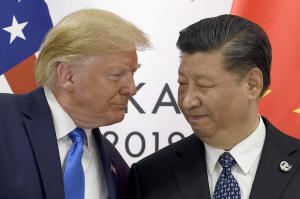The more Trump talks about making trade deals, the more confusing the
tariff picture gets
[May 08, 2025] By
JOSH BOAK
WASHINGTON (AP) — The more President Donald Trump talks about his
efforts to reach deals with America's trading partners, the more
confusing the tariff picture gets. His team seems good with that, saying
Trump is using “strategic uncertainty” to his advantage.
Trump says the United States does not have to sign any agreements, and
that it could sign 25 of them right now. He says he is looking for fair
deals on all sides, and that he does not care about other countries'
markets. He says his team can sit down to negotiate the terms of a deal,
and that he might just impose a set of tariffs on his own.
“I am struggling to make sense of it,” Chad Bown, a senior fellow at the
Peterson Institute for International Economics, wrote in an email.
Late Wednesday on his social media site, Trump wrote that he’ll be
holding a news conference Thursday morning concerning a “MAJOR TRADE
DEAL WITH REPRESENTATIVES OF A BIG, AND HIGHLY RESPECTED, COUNTRY.” He
added that it would be “THE FIRST OF MANY!!!”
Although Trump's team holds up his best-selling book “The Art of the
Deal” as proof that he has a master plan, much of the world is on
tenterhooks. That has meant a volatile stock market, hiring freezes and
all kinds of uncertainty even as Trump continues to promise that new
factories and jobs are on the horizon.
A look at how the trade talks may play out:

Trump still wants tariffs
As part of any deal, Trump wants to keep some of his tariffs in place.
He believes the import taxes can generate massive revenues for a heavily
indebted federal government even though other countries see the whole
point of striking a deal as getting rid of tariffs.
“They’re a beautiful thing for us,” Trump said recently about tariffs.
“If you can use them, if you can get away with using them, it’s going to
make us very rich. And we’ll be paying off debt, we’ll be lowering your
taxes very substantially because so much money will be taken in that
we’ll be able to lower your taxes even beyond the tax cut that you’re
going to be getting.”
So far this year, the U.S. government has collected $45.9 billion from
tariffs, about $14.5 billion more than last year, according to the
Bipartisan Policy Center. Those revenues could escalate sharply given
the 10% baseline tariffs, the 145% rate being charged on Chinese goods
and rates as high as 25% on steel, aluminum, auto and Mexican and
Canadian imports.
To reach Trump's stated goals of repaying the $36 trillion debt and
reducing income taxes, his tariffs would need to raise at least $2
trillion annually without causing the economy to crash in ways that lead
to lower overall tax revenues. That would be close to impossible
mathematically.
How do negotiations work?
The Republican administration has said 17 of its major 18 trading
partners have essentially presented them with term sheets, which list
the possible compromises that they are prepared to make. Agreeing to a
mutual understanding of the terms would be only the start of any trade
talks.
But foreign leaders have said it is unclear exactly what Trump wants or
how deals could be codified into a durable agreement. They also know
Trump approved the United States-Mexico-Canada Agreement in 2020, only
to charge new tariffs on those same two trading partners this year.

While meeting with Trump on Tuesday, Canadian Prime Minister Mark Carney
suggested the next version of that agreement would need to be
strengthened to prevent a repeat of the fentanyl-related tariffs imposed
this year by Trump that Canada saw as arbitrary.
’Some things about it are going to have to change," Carney said.
Can the US reach a deal with China?
The 145% tariffs on China — and the 125% tariffs on the U.S. that
Beijing imposed in response — hang over the entire negotiating process.
Treasury Secretary Scott Bessent acknowledges that those tariffs are not
“sustainable.”
The first talks between the U.S. and China are set to begin this weekend
in Switzerland, but they will likely be limited to finding ways to
de-escalate tensions enough for meaningful negotiations to take place.
[to top of second column] |

U.S. President Donald Trump, left, meets with Chinese President Xi
Jinping during a meeting on the sidelines of the G-20 summit in
Osaka, Japan, June 29, 2019. (AP Photo/Susan Walsh, File)
 The key issue is that China is the
world's dominant manufacturer, which makes also makes it a leading
exporter in ways that can supplant domestic industries. Because
China suppresses domestic consumption and focuses on production, the
rest of the world buys what it makes because there is not enough
internal demand. The U.S. wants to rebalance trade, but it has done
so also through tariffs on countries that could be its natural
allies in defending their auto and tech industries against China.
“Obviously in this trade puzzle, China is the
biggest piece,” Bessent said this week. “Where do we end up with
China?”
Chinese Foreign Ministry spokesperson Lin Jian has suggested that a
meaningful way for the Trump administration to jump-start talks
would be to pull back on its rhetoric and punitive import taxes.
“If the U.S. truly wants to resolve the issue through dialogue and
negotiation, it should stop threatening and pressuring and engage in
dialogue with China on the basis of equality, respect and mutual
benefit,” Lin said Tuesday.
Asked on Wednesday whether he would reduce the tariffs on China as a
condition for negotiations, Trump said, “No.”
The president also disputed statements by the Chinese government
that his administration sought the talks in Geneva. “Well, I think
they ought to go back and study their files," Trump said.
Would Congress need to approve any deals?
Not necessarily.
Trump unilaterally imposed his universal tariffs without Congress,
using the 1977 International Emergency Economic Powers Act to do so,
which has led to multiple lawsuits. The administration also
maintains that any agreements to change the rates would not need
congressional approval.

Previously, presidents, including Trump in his first term with his
“Phase One” China deal, could negotiate only “more limited
agreements that have focused on select bilateral trade and tariff
issues,” according to a Congressional Research Service report
updated this April. Other examples of limited deals include a 2023
agreement on critical minerals and a 2020 deal on digital trade with
Japan.
The challenge is that Trump has also made nontariff barriers such as
safety regulations for autos and the value added taxes charged in
Europe part of his talks. He wants other countries to change their
nontariff policies in exchange for the U.S. reducing the new tariffs
he introduced. Other countries, in return, might object to U.S.
subsidies to its companies.
In theory, it would take House and Senate approval to complete a
deal that would address “non-tariff barriers and require changes to
U.S. law,” the Congressional Research Service report said.
Is it really a deal if Trump just imposes it?
If other countries fail to satisfy him, Trump has suggested he will
just do some kind of internal deals and set a tariff rate, although
he technically already did that with his April 2 “Liberation Day”
tariffs. The import taxes announced by Trump then led to a financial
market sell-off that caused him to pause some of his new tariffs for
90 days and charge the lower 10% baseline rate while negotiations
take place.
It appears Trump will agree not to impose the originally threatened
tariffs if he thinks other countries are making adequate
concessions, essentially meaning that the U.S. gives up nothing
because the tariffs are new. But Trump might also pull back his
tariffs without necessarily getting much in return.
“Trump is notorious for making maximalist demands and then
retreating as negotiations go on, so we’ll see how long he sticks
with his formula,” said William Reinsch, a senior adviser at the
Center for Strategic and International Studies, a Washington think
tank. “But so far it is pretty clear that countries coming in and
wanting a ‘normal’ trade negotiation with both sides making
substantive concessions are being rebuffed.”
All contents © copyright 2025 Associated Press. All rights reserved |